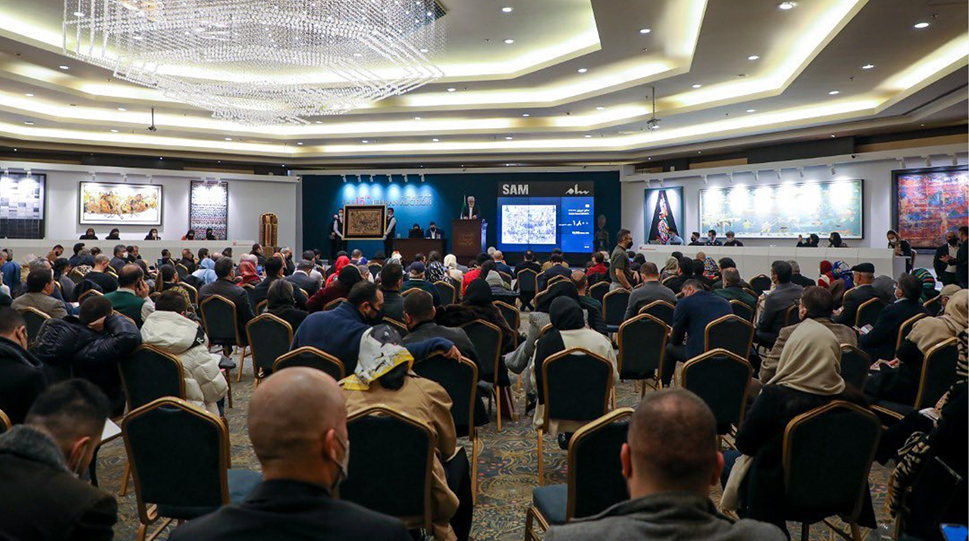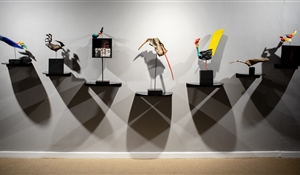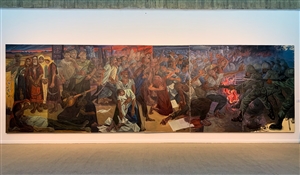A Review of the 15th Edition of Tehran Auction
18 Jan 2022Original text in Farsi by Safoora Seyedi - Shamim Sabzevari
Translated to English by Sara Faezypour
The 15th edition of Tehran Auction ended with a sale record of 158 billion and 890 million tomans. 80 pieces by 60 Iranian artists were present in this year's edition, 35 of which were valued at a starting bid of one billion tomans. In total, out of 59 paintings, 13 calligraphy paintings, and 8 sculptures, all pieces were sold. These four artworks were each sold for more than 10 billion tomans: "Seated Poet" by Parviz Tanavoli, "Shiraz" by Monir Farmanfarmaian, "La+La+Sar" by Hossein Zenderoudi, and "Untitled" by Sohrab Sepehri. What was definitely one of the surprises of the event was the triptych piece by Bahman Borojeni, since this painting entitled "Music" was sold for 600 million tomans with an increased rate of 380 percent. Likewise, Iraj Eskandari's "The Red Intellect" was sold for six times more than the starting bid with the highest price increase and the same growth of 380 percent. What was also surprising in the event was Hodjatollah Shakiba's painting being sold for 650 million tomans with an increased rate of 271 percent, a rare happening for the artist. Furthermore, two pieces by Jafar Rouhbakhsh, a prominent artist of the Saqakhaneh school were auctioned in total for the value of 4 billion and 50 million tomans. Tehran Auction also provided an opportunity for artists such as Ali Golestaneh, Yaghoub Emdadian, and Massoud Arabshahi to shine again. Arabshahi was present in the event with two artworks, both of which were sold at a higher price than the starting bid.

Sohrab Sepehri
Sohrab Sepehri was one of the key figures of the event, earning the title of "the most expensive artist of the 15th Tehran Auction" with the sale of two of his pieces at the prices of 6 and 11 billion, meaning a total of 17.8 billion tomans. Sepehri's "Untitled" had the highest price increase and rate growth, being sold at 6 billion tomans, which was twice the minimum estimate with a growth rate of 71 percent compared to its initial mid-range estimate. The second painting from his "Tree Trunk" series, was sold at 11 billion and 800 million tomans. The first piece reached Tehran Auction for the second time, having been displayed in the 4th edition of the Auction, but the latter found its way to the event from a private collection for the first time. In the book "The Oasis of Now", Dariush Shayegan stated, "The domination of subjectivity over objectivity was Sohrab's painting ideal"; this could clearly be said about both works. The first piece is the reminiscence of the artist's diligence in achieving what Shayegan refers to as "the space beyond" where "the causal connections of the perceptible world, the rational sequence of time, and the homogeneous space of geometric shapes have no place". At first glance, although the color palette of the artwork is the painter's usual one, containing colors that Sepanlou called, "the cognate spectrum of the colors of Iran's climate", it could be claimed that the narrative of this artwork is different from Sepehri's other works in the event as the colors are particular and personal. The poet-like painter audaciously disrupts the harmonic balance of the piece with red patches. The left corner of the work is where the red patches and the black lines are concentrated while its right side only comprises a brown mass to, perhaps, conjure the passage from disorder to stillness.
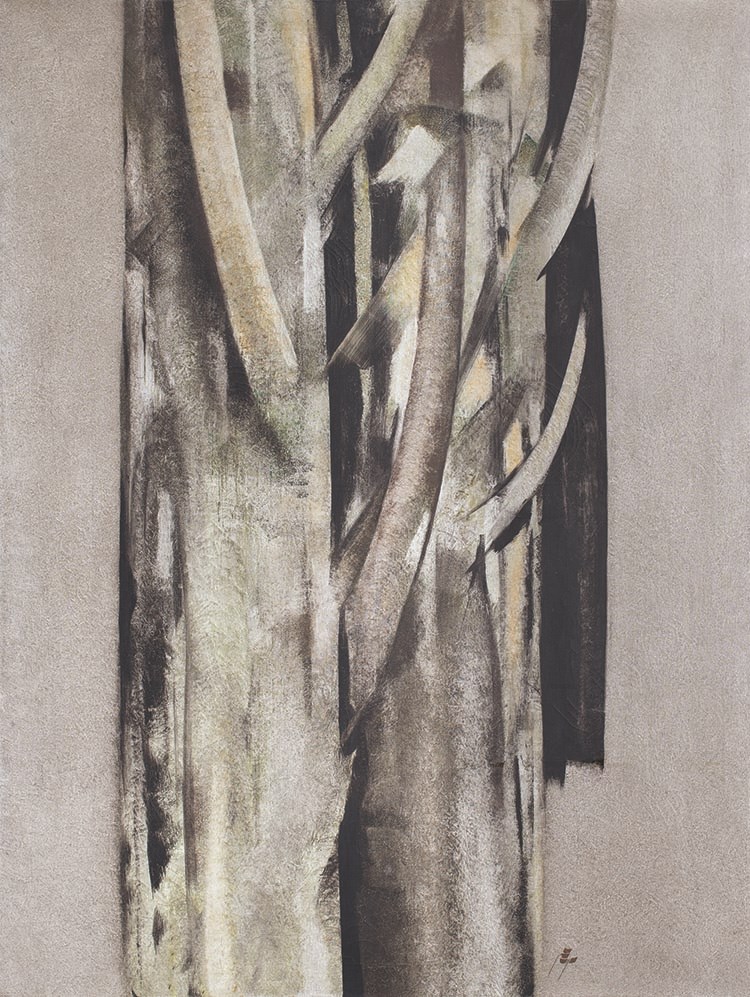
Sohrab Sepehri | Untitled | 1960 | oil on canvas | 130 × 100 cm
Created in 1961, "Untitled" is a summarized nonrealistic image of tree trunks, reaching the boundaries of abstraction; Sepehri's pristine reflection of his contemplation of the surrounding world and the image created in the artist's mind by observing nature. This simple, abstract, serene, still piece is a testament to the artist's view of real-world phenomena. He applied mystical inclinations, especially the teachings and doctrines of Zen Mysticism in the poems and paintings of this period, acquiring a sense of internalization and personalism in his perception of nature. Fleeing the hubbub, commotion, and unrest of the world, he took refuge in the inner world, leaving behind his interpretations in the form of poetry and painting for the same chaotic and restless outside world.
Like most of Sepehri's paintings, this piece is composed of a combination of positive and negative spaces, plain and neutral colors, and an abstract impression of nature. With swift and precise brushstrokes, he depicted a mass of tree trunks in the center of the frame so that the boundaries between each are blurred, and it is not possible to exactly distinguish the trunks' outline; however, the huddle in the middle of the frame, creating a sense of heaviness, next to the emptiness and stillness of the surrounding space, not only gains an additional meaning but also provokes the desire to explore. The vertical tree trunks in the middle of the frame are painted with gray, brown, and ochre color tones; nevertheless, this plainness and homogeneity are not tiresome to the eyes, but rather direct the eye of the viewer to somewhere outside the frame whether it is from above or below, along the lines of the tree trunks, or from the sides, seeming to expand the scope of the frame. What is most responsible for granting motion and dynamism is the oblique lines in the middle of the frame, created by the expressive movements of the brush, going towards the surrounding empty space and reaching balance with the vertical lines. In fact, the entire space can be divided into two parts: the surrounding empty space, and the heap of trees in the middle of the frame, creating a strange contrast; however, in the end, the homogeneity of the background color with the tree trunks emphasizes the concept of unity albeit plurality.
Essentially, the free movement of the brush, the fluid coloring, the dominance of neutral colors, the interrelation of the colors and lines, and the emphasis on empty spaces are not meant to depict an outside phenomenon or a realistic representation of tree trunks, but are aimed at displaying a world that the artist observes, understands, creates, and polishes with his poetic sensitivity and deep insight; the discovery and knowledge of a world that, as it happens, could not be seen, requiring inner understanding. The tree trunks seem everlasting in the non-time and non-place space. Their details are removed so that the mental exploration process would take place through becoming one with the essence of the trees. Influenced by the mystic teachings, it could be said that Sepehri was mostly searching for the spirit of nature; therefore, the abstract, nonrealistic landscapes, void of humans, were greatly in harmony with his poetic spirit; an insight that is solely acquired by becoming one with nature, uniting the entirety governing the outside world with the artist's romantic soul.
Farideh Lashai
Farideh Lashai was another shining star of the 15th Tehran Auction. Two of her works were auctioned for the total value of 5 billion and 400 million tomans. "Uncertainty is a way to expand and develop an idea", stated Lashai in a conversation. The same quote could summarize how she performs in creating art. Like Expressionist and Romantic painters before her, she reminds the viewer that her perception of the environment is unique.
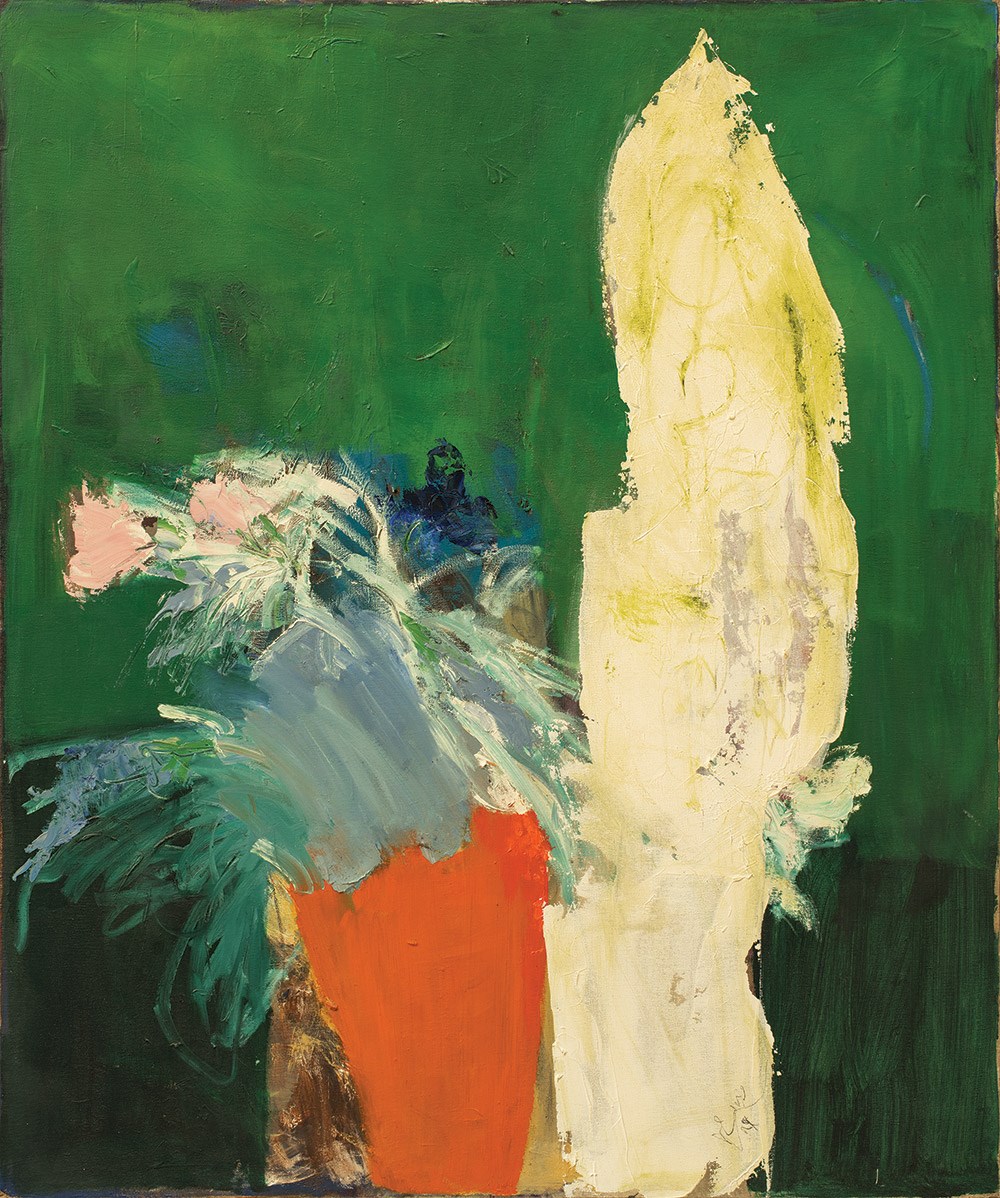
Farideh Lashai | Untitled | 2007 | mixed media on canvas | 120 × 100 cm
For Lashai, reality is an inconsistent concept, the observation, and understanding of which is completely dependent on our sensual abilities, which could perceive any fixed environment as either adorned, ambiguous, vitalizing, or miserable. The talent of a poet, artist, or instrumentalist thrives in the gap between reality and perception, in being able to depict some kind of physical or tangible representation of how we understand the world. This is what leads us to Gorky's statement, saying, "abstraction allows man to see with his mind what he cannot see physically with his eyes. This is the emancipation of the mind". It is precisely this unseeable aspect of our surroundings that Lashai so poetically renders.
Lashai has utilized a variety of techniques and methods in different periods, but what has formed her most significant aspect and most celebrated works is a kind of poetic view of nature, directing her work method towards an abstract language. To face the phenomena existing in the real world, she has adopted a personal and inner approach, attempting to experience and comprehend everything in the moment. Thus, her encounter with phenomena such as flowers and trees, recurring in her work, has led to a kind of stimulating painting with vibrant brushstrokes, vivid and thick colors, and an emotional and sentimental approach.
This attitude towards nature could be seen in her "Untitled" painting (2007). In dealing with the pot and flower on the table, instead of realistically representing the components and recording the concrete nature, she has depicted her mental perception of the objects with swift brushstrokes, trying to render the circumstance. The artist's inner and emotional preoccupation is manifested in line and color. The original image, an orange pot with pink and blue flowers in a green background has turned into its shadow. The green background makes a charming contrast with the orange pot, a composition that adds energy and vitality to the entire work. The shape of the flowers, reduced to small color spots, merges into the background, and the milky white patch on the right side of the frame, covering almost that entire area, has toned down the drama of the left side of the image. Perhaps, what is most visually exciting can be traced in the midpoint of the frame, where the leaves are depicted in Lashai's own style. The sharp movement of the brush has resulted in the color spreading with a back-and-forth movement in this part, seeming as if the leaves were originally depicted with a more accurate form; even though the other leaves in the pot are far from reality as well, their connection with the outside world could still be discerned. Presumably, this arrangement was made to move the atmosphere of the painting away from realistic representation so the final result would be more closely related to Lashai's own idea and working style.
Additionally, choosing the bottom line of the canvas as the horizon line and the position of the pot on it shows the creative mind and dynamic composition, she has thought of creating the work. Even though because of the accumulation of red color, the darkening of the lower area, and the use of black, the bottom of the frame has gained more visual weight, leaving the top of the image empty, merely covering the surface of the canvas with green, does not disturb the visual balance since the dynamic movement of the brushstrokes, as well as the elongation of the white surface, draws the eyes towards the top of the canvas.
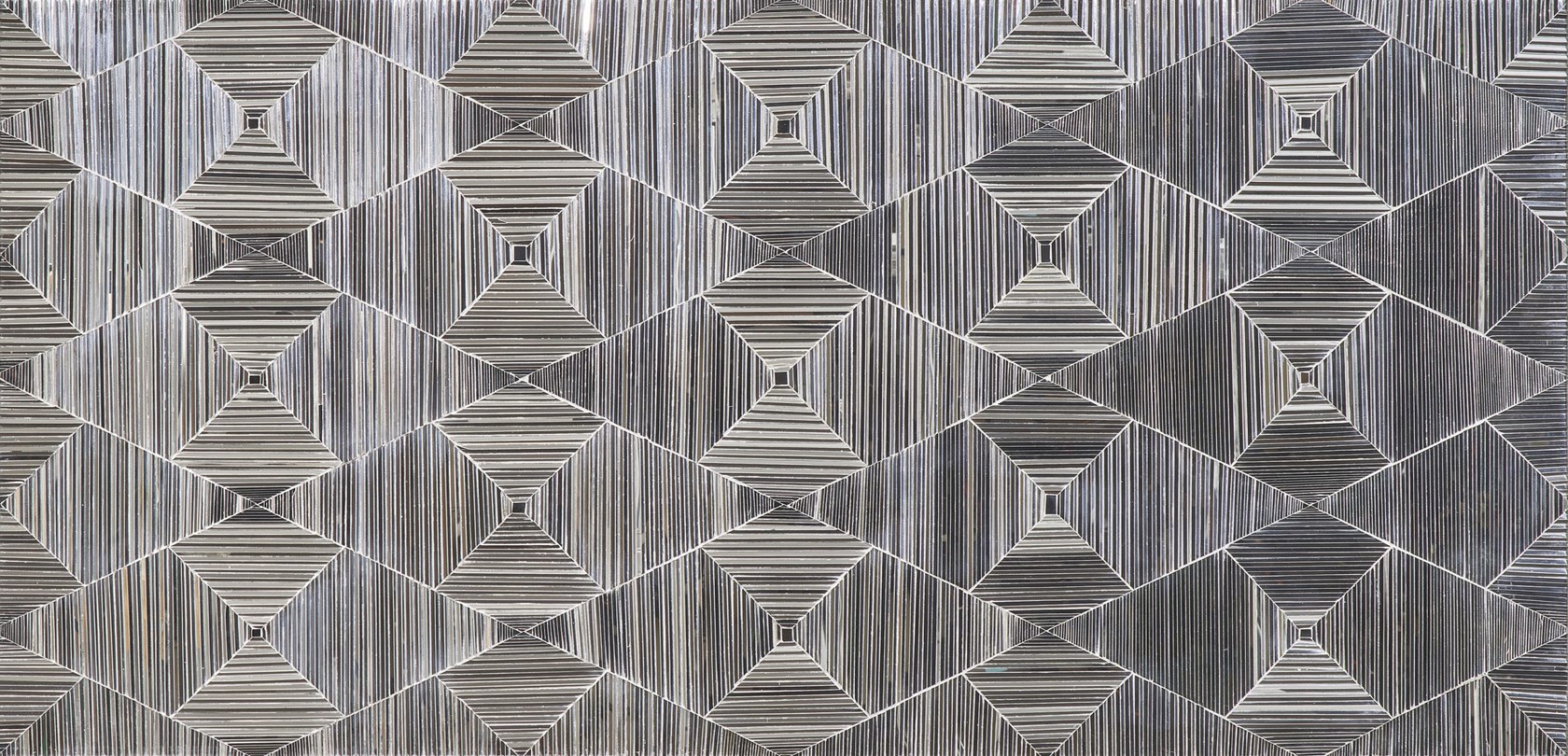
Monir Shahroudy Farmanfarmaian | Shiraz | 2009 | mirror mosaic and plaster on wood | 72 × 150 cm
Monir Farmanfarmaian
Monir Farmanfarmaian has shaped her personal language by fusing geometry and traditional decorations of Iranian-Islamic art with formalistic designs and the abstract approach of Western modernism. Her precise and geometrical mirror mosaics and designs with shining glass are well-known in the world. In this year's edition of Tehran Auction, two of her invaluable pieces, "Shiraz" and "Variation of Hexagon" were featured. "Shiraz", a combination of mirror mosaics and plaster on wood, was presented to art enthusiasts at Hauser and Wirth in London in 2013, and the 10th Tehran Auction in 2019. Auctioned at the starting price of 8 billion tomans, the piece was sold at 13 billion tomans, breaking the record of 12 billion tomans belonging to Aydin Aghdashloo.
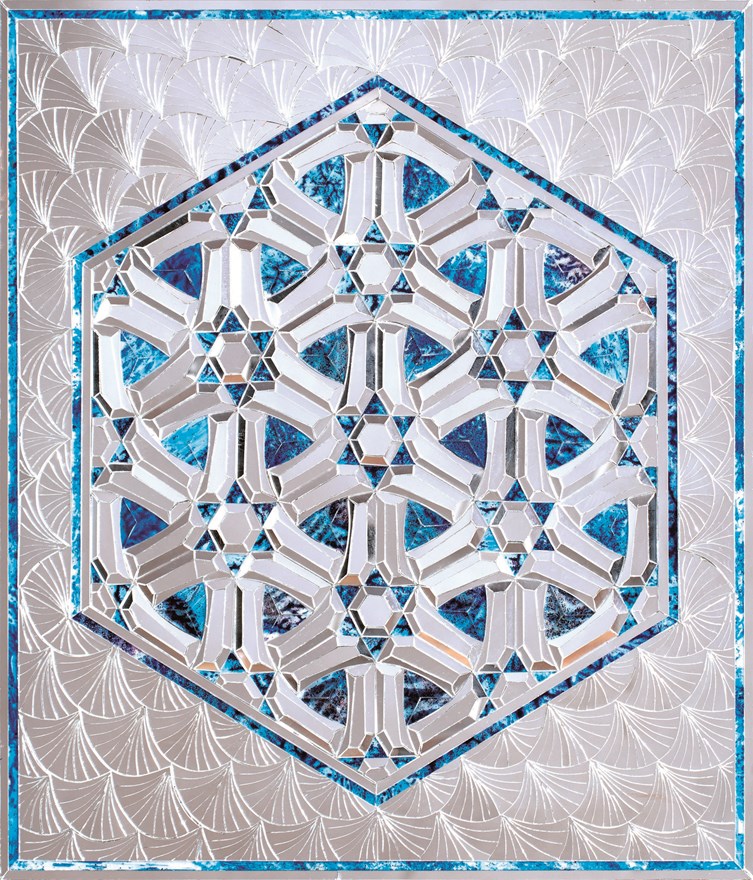
Monir Shahroudy Farmanfarmaian | Variation of Hexagon | 2014 | mosaic mirrors and reverse glass painting on plaster and plexiglass | 36 × 32 cm
Apart from aesthetic features, a visible symbolism, manifested in the artist's interest in the mirror as a medium, could be detected in Monir's artwork. In Sufi traditions, the concept of divinity is interwoven with the concept of the "self". In Monir's work, the mirror is used as a metaphor for self-examination and the inner journey. According to Hans Ulrich Obrist, swiss art curator, critic, and historian, Farmanfarmaian's artwork is conforming to as well as in service of her memory that is as multi-dimensional as the artist herself, taking the audience back within, to themselves, the past, and the homeland. Her art is a blend of Iranian elements and an appealing and modern taste. Even though she talks in the language of her country's traditional architecture, the unique abstract style of "Shiraz" is why it is considered a modern work as much as it contains traces of the past.
Created in 2009 using glass, "Shiraz" is based on regular geometric division and the repetitive form of small and large polygons, consistently covering the entire surface of the piece. The periodic repetition of shining diamonds, each consisting of four main sides and several partial sides draws the eye across the entire surface of the work without creating a monotonous and tiresome atmosphere. The juxtaposition of the diamonds' diagonal lines and the inner vertical and horizontal lines has created an attractive variety. The intersection of the horizontal and vertical lines has formed a square shape in the middle of each diamond. Everything is accurate, neat, and completely geometric. Although the emphasis on geometric structure and order is reminiscent of geometric structuralist movements of the early 20th century, it is deeply rooted in Eastern thoughts, highlighting the sacred geometry, which shapes the basis of Islamic decorations. The metaphoric wisdom is implemented in the tile works, the mirror works as well as the precise method of constructing the arches, muqarnases, and domes of the traditional Iranian palaces, and houses, attempting to somewhat represent plurality albeit unity as well as universe order. That Farmanfarmaian combined a traditional image in Eastern art with modern thought, presenting the artwork in a two-dimensional format, demonstrates her pioneering and creative view. The precise order and unique geometric structure, combined with the flash of the mirrors and the ability to reflect the images inside them, has acquired another dimension. From this point of view, it could be acknowledged that her art is as much indebted to modern art as it is in accordance with conceptual art currents, especially the placement of the mirror mosaics in an environment which reflects inside them, creates a new image and structure each time. The image of the viewer reflected in the work builds a special interaction between him or her and the artwork.
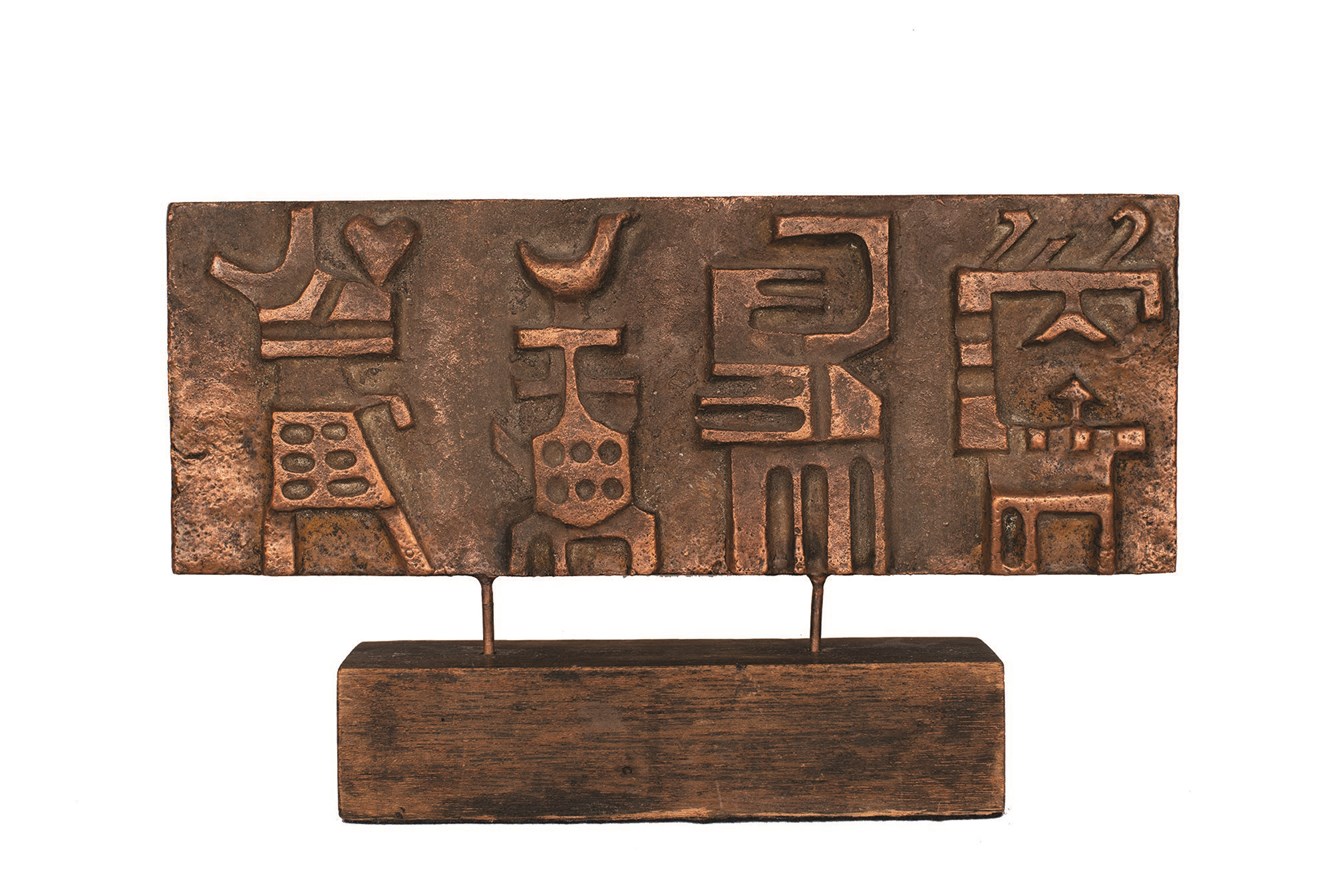
Parviz Tanavoli | The Brick of Persepolis VI | 1976 | bronze and wood | 19 × 31 × 5 cm
Parviz Tanavoli
During his more than six decades of artistic activity, Parviz Tanavoli has tried to recreate the traditions, culture, and art of Iran with a modern approach, using various materials as well as reviving the Iranian identity and vulgar elements, utilizing the art language of the day. Tanavoli's sculptures could be categorized into different groups, of which the "Poet" is one of the most renowned.

Parviz Tanavoli | Seated Poet | 2009 | bronze | 142 × 53 × 58 cm
He has adopted Iranian mythological and fictional themes, such as "Farhad the Mountain Carver" in his Poet sculptures. Viewing and exploring Iranian art and culture with a personal approach, Tanavoli acknowledges Farhad as the sole Iranian sculptor artist, who axed Bisotoun Mountain and sacrificed his life for his love for Shirin. Farhad was not only an irreplaceable and skillful artist but also an infatuated lover. It was the same love and affection that made him immortal in the end. Showcasing his first examples of "Farhad" abroad, Tanavoli decided to change the title of the collection to "Poet" so that it would be also meaningful in English. "His Poets are mountain carving Farhads who despite manhood, strength, and rigor are calm, flexible, kind, and amorous. In these artworks, the two contradictory concepts of vigor and romantic softness are embodied and represented in geometric forms with the softness of edges and the rigor of vertical shapes."
Over the years, Tanavoli has created a myriad of Poets with different materials and in various sizes; however, similar to many of his works, the Poets do not have a defined and specific form whereas their identity is redefined each time in some way. Sometimes they are standing still, quiet and alone in their place, and other times, they are depicted next to a lover, or finalized with a bird.
Named "the most expensive piece of the 15th Tehran Auction" at the price of 14 billion and 600 million tomans, "Seated Poet" is one of Tanavoli's recent bronze sculptures. A distinctive geometry and form have been implemented in the work. More than suggesting the form of a human body, this Poet is similar to a chair, yet it is composed of the three main parts of the human body. The head, upper body, and lower body can be distinguished. If the upper part of the sculpture could be considered a symbol of the head, an empty hole exists there that could be regarded as the eye and its empty socket. The upper body is also divided into three parts, appearing to be the middle part of the human body with the hands placed next to it. Tanavoli has made interesting use of calligraphy in this sculpture; however, unlike its other parts, covered with unknown words, the middle section is void of typography, displayed in the shape of a smooth and polished cylinder. Perhaps, it could be considered a symbol of a pure and gracious heart with nothing in it. The lower body is, in fact, the seat of the chair. The entire sculpture is reminiscent of an abstract human body form, leaning on a chair and, perhaps, waiting; an eager poet, whose whole being is brimming with words that he might be able to offer his lover, despite owning a pure, sincere, and bright heart.

Bahman Borojeni | Music | 2021 | acrylic on canvas | 100 × 219 cm
Bahman Borojeni
At first glance, Bahman Borojeni's "Music" strikes one as being similar to an Abstract Expressionist painting. The happy and soft pink and blue pastel colors next to the dark blue, white, yellow, and gray lines and color patches have created a dynamic, vibrant and rhythmic composition. Following along those lines and colors, the inner form of the piece is uncovered: female dancers and musicians depicted footing it, cheering and feasting. The concept of "music" is interpreted in the piece in three ways; firstly, the title of the work; secondly, the dynamic form and dancing bodies spring the concept to mind; and thirdly, the word music itself both written in Persian and English on the top right corner of the frame. Created in 2020, this triptych excellently depicts the concept and the hustle and bustle of a ceremony of dancing and moving the body, using lines and patches of color. Instead of emphasizing the contours of the bodies, though still visible in some parts, Borojeni has managed to concentrate on the nature of the subject. With a Futurist approach, he has implemented repetition and sequential depiction to demonstrate movement and dancing. Choosing a language close to Abstract Expressionism to more easily express the concept has been wise and, of course, efficient.



